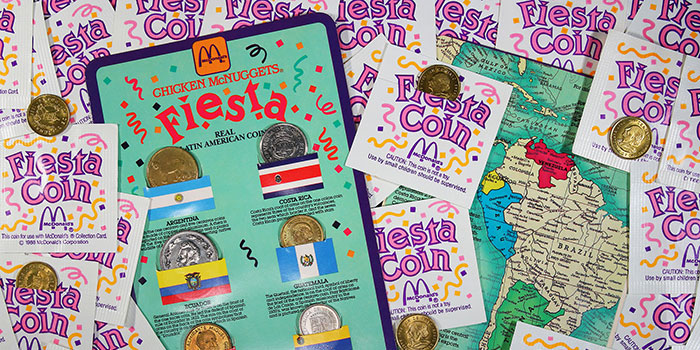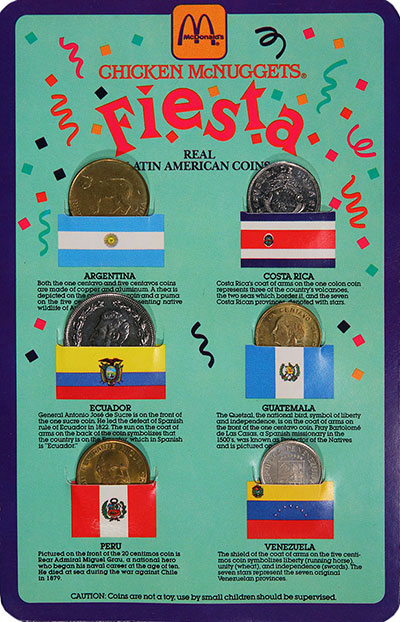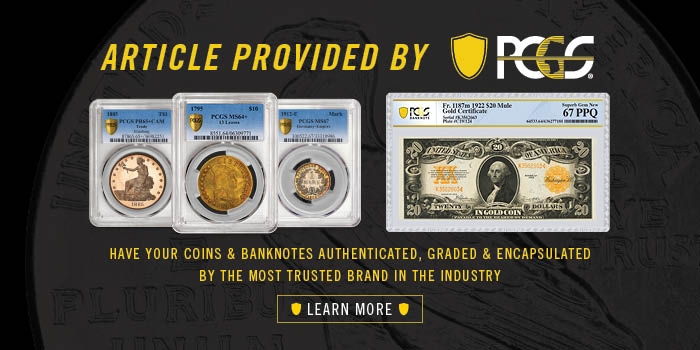
By Jay Turner for PCGS ……
The promotion of numismatics in general society is one of many ongoing goals for the hobby, and countless such efforts have occurred throughout the years.
Yet one such promotion seems forgotten by most, when America’s largest fast-food chain, McDonald’s, offered coins to promote the hobby and of course their new menu items.
In 1988, McDonald’s introduced three new dipping sauces for their Chicken McNuggets. These sauces, Mesquite BBQ, Green Chili Salsa with Jalapeño Peppers, and Mild Salsa with Chunks of Tomato and Onion, were promoted as part of their Fiesta menu, along with the Fiesta Colada Shake featuring a “delicious creamy blend of pineapple and coconut.” As an added bonus, those who ordered an item off their Fiesta menu would receive a promotional Fiesta Coin, which came encased in a white factory-sealed package. On the package was purple text reading “Fiesta Coin” and blue text below with the McDonald’s logo and “This coin for use with McDonald’s ©Collection Card, ©1988 McDonald’s Corporation” written on one side and the other bearing the words “CAUTION: This coin is not a toy. Use by small children should be supervised.” Orange, purple, and blue design elements featured around the packaging were to look like confetti and string.
Along with the Fiesta Coins, a McDonald’s Chicken McNuggets Fiesta Coin board was offered as a holder for the coins, subtly urging customers to collect all six of the country’s coins being offered. This board had space for the “Real Latin American Coins” offered as a promotion in the fiesta holders. The coins came from six “South of the Border” countries, including Argentina, Costa Rica, Ecuador, Guatemala, Peru, and Venezuela. Each slot on the card was made of the respective country’s flag and had a little information about each coin. The back of the coin board card featured a map of Central and South America with the countries’ coins being highlighted in color along with a brief description of the nation.
An additional section on the card noted that people could reach out to the American Numismatic Association (ANA) at their mailing address or to the public library for more information about the coins or coin collecting.
For this initiative, McDonald’s was to give out 30 million coins across the United States in the “Fiesta Coin” promotional packaging. The coins were the following:
 Argentina
Argentina
Two different denominations were offered as promotional coins: the 1 centavo featuring the rhea bird (1985-1987) and the 5 Centavos depicting the Argentine cougar or puma (1985-1988). Argentina emerging from a military government to a new democracy in 1983 saw a monetary reform from pesos argentine in 1985 to australes in June 1985 until December 1991. The currency continued to fall against the United States dollar (USD), trading at 0.855 to the USD in June 1985 to 5.50 to the USD in January 1988. By December 1988, the currency traded at 16.41 to the USD, and no centavo coins were minted in 1988 due to their value.
Costa Rica
The Costa Rica colon (1982-1984). The Costa Rican colon had an exchange rate of 232.60 colon coins to the USD in 1989.
Ecuador
The Ecuador sucre (1985-1986). The 1985 issues were minted in Germany and the 1986 issues are minted by the British Royal Mint. During the 1980s Ecuador had just returned to democratic rule. Despite the best efforts of the government, the nation went through massive inflation with its currency. In 1986, the exchange rate for one dollar was 122.78 Ecuador sucres. In 1987, this had grown to 170.46 for $1USD. By 1988, with the coins being handed out as promotional items, $1USD was equal to 301.61 Ecuador sucres.
Ecuador eventually had to abandon its own currency and switch to the United States dollar, the currency they still use today.
Guatemala
Guatemala 1 centavo (ca. 1988). To represent Guatemala, McDonald’s used the 1 centavo – virtually all of which seem to be dated 1988 for this promotion. During 1988, Guatemala was under the Cerezo Administration and with a civil war going on since the 1960s the government was almost overthrown in May 1988 by a military coup. The Guatemala exchange rate in 1989 was about 6.0653 to $1USD, which means the centavo was about six coins to one United States cent.
Peru
Peru 20 centimos (1985-1987) from the Lima Mint. The exchange rate with the USD in 1989 was 2.6642 per dollar.
Venezuela
Venezuela 5 centimos (1986). The coins from Venezuela were all 1986 5 centimos pieces. Venezuela had one of the most stable and valued currencies in South America, but after “Viernes Negro” or “Black Friday” in 1983 the Venezuela bolívar suffered an abrupt devaluation against the US dollar. It is hard to pin down exact values due to the massive currency fluctuation of the period, but by 1988 the smallest denomination coin Venezuela was producing was the 25 centimos.
Offering these virtually valueless coins as an incentive to purchase McDonald’s products was not a costly expense for the United States’ largest restaurant chain. Printing the coin board holders was likely the greatest cost for McDonald’s, outside of distribution.
The “Fiesta” promotion was spurred by the rise in popularity of Mexican food in the United States. Sit-down Mexican food restaurants began to introduce Americans to salsa and chips before their meals and soon the American appetite for salsa grew. Between 1985 and 1990, the sales of salsa increased in the United States by 79%. McDonald’s hoped to capitalize on this trend.
The “Fiesta” sauces had nothing to do with the countries represented on the coins given as promotions. Mesquite BBQ is from the use of several plants in the Prosopis genus, which is native to Mexico and the American Southwest. Green chili salsa with jalapeño peppers is also known as salsa verde, which is a Mexican cuisine sauce tracing its origin back to the Aztec Empire, located within the borders of modern Mexico.
Only the Mild Salsa with Chunks of Tomato and Onions has some connection with the promotional coinage. Often considered a Mexican dish, salsa traces back to the Aztec, Inca, and Mayan Empires, which include modern-day Mexico for the Aztecs; Peru, Ecuador, and Chile for the Incas; and Mexico, Guatemala, Belize, El Salvador, and Honduras for the Mayan Empire. The other promotional item, the Fiesta Colada Shake, is that of Piña Colada origin and can be traced to Puerto Rico. Hindsight on the promotion some 30+ years later, the promotion can look culturally insensitive, especially watching their commercials for the promotion on YouTube.
So now the question can be asked: was the promotion successful? The answer isn’t publicly known, much like the number McDonald’s lost for their 1984 Olympics campaign. What is known is that the three sauces and the shake were not made normal menu offerings and have faded into nostalgia. In reading employee accounts regarding the promotion, it appears that numerous Fiesta Coins were never given out, and some even state that cases were taken home rather than discarded. This appears to be backed up with evidence of entire cases of factory-sealed coins being offered for sale from time to time in auctions and on eBay. Some sellers continue to offer quantities of sealed coins for sale, and with 30 million coins being distributed for promotion, the Fiesta Coins continue to have little value today.
When you have a passion for something, you want to promote it. News headlines heralding the sale of seven-figure trophy coins, social media posts covering interesting finds of old or valuable coins being dropped into circulation by collectors and dealers, and the United States Mint release of scarcities into commerce all contribute to the goal of promoting numismatics.
McDonald’s wasn’t unique in this mass coin promotion at the time, but offering free coins – even if they had little value – to the American public likely helped the hobby in 1988.
* * *





